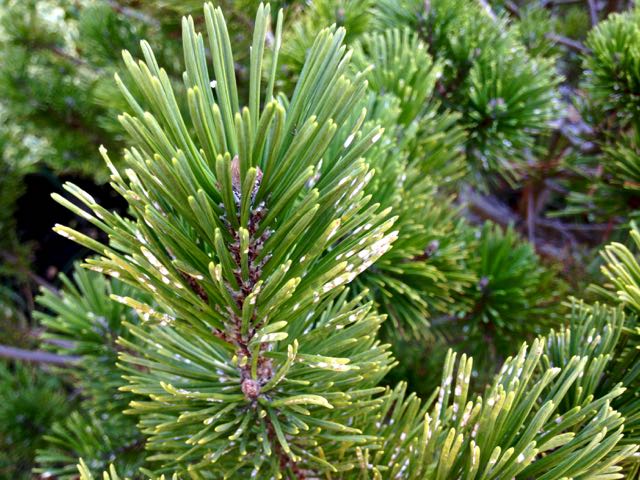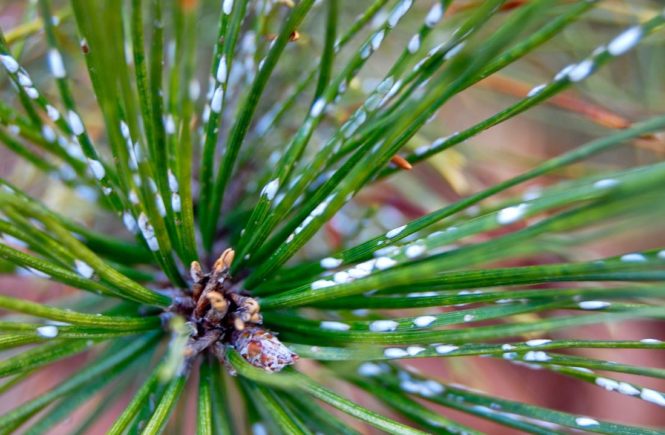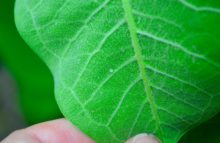If you see white dots like these on pine needles, you might mistake them for something the tree produces itself, like pine gum. I did at first, too. But nope.
Dots that look like small splashes of white paint or resin on the needles are the winter homes of an insect pest called pine needle scale (Chionaspis pinifoliae). These critters suck. Literally. That’s how they feed, and a bad infestation can damage needles and cause them to drop.
While there’s nothing much in the garden to distract you, head out now and identify any scale on your trees. When things get busy in late spring and early summer, you’ll be ready to control them before serious damage is done.

While it doesn’t go into particulars about pine scale, the University of Guelph (PDF) has a general explainer about how scale insects work. Pine needle scale is an armoured scale – meaning they make a hard waxy shell (the white stuff in our pictures) that protects overwintering eggs and females from predators – as well as from our attempts to, well, kill them.
Another reason they suck is that the Ontario Pesticides Ban limits how we Ontario home gardeners can treat scale insects. We can’t use the Class 9 pesticides often recommended in other jurisdictions.
Instead, we have to use less drastic measures. These include pruning out light – or, paradoxically, really bad – infestations, or spraying with summer horticultural oil (lighter weight than dormant oil) and insecticidal soaps.
Careful on white pine (Pinus strobus) though. It’s sensitive to oil sprays. Always read the instructions.
When spraying, timing is essential. It only works if the spray makes direct contact with the soft-bodied crawlers or nymphs after they’ve emerged from the shell. Get your eyeballs out to look for the tiny, oval, brownish early stages. That’s the best way to know for sure it’s spray time. Zip over to this PDF from Penn State University for pictures and details.
Keep in mind where you live, compared to any online resources – including Toronto Gardens. So, while the Missouri Botanical Garden website also has good info, the timing for Toronto’s climate would likely be June rather than early May. Your climate might differ.
Also note that Neem is not yet on the okay-to-use-as-pesticide list in Ontario. Just because we can find it on the shelf at our local hardware store doesn’t mean we’re allowed to use it.
Have you seen this pest on pines near you? And have you had experience treating it? Chime in. As always, we’d love to hear from you.





6 comments
I’ve heard of this but have yet to encounter it (thankfully) – but perhaps a more thorough inspection of the trees on our property is in order.
It’s a good time to eyeball your trees and shrubs for any type of scale while you’re making your winter rounds. This one is easy to miss, as it isn’t that noticeable without a close inspection – until it gets really bad, and the needles start looking frosty.
Thanks for this. A young pine sapling of mine had this or something similar last year. At one point I could see and remove by hand little creepy crawlies and gave it a few soapy water treatments. Lost a lot of needles but late in the season new growth had come through. I will def be watching more closely and SOONER thanks to your post.
I feel mighty when scratching off the few scales I find on my small dogwood, which can be a target. I do it before the leaves emerge, when every twig is on view. So far, it has been only a handful of scales. But if I get my timing right this year, it should cease to be a problem.
This only became noticeable last week as I winterized my potted spruce which is isolated on a terrace. So where did these bugs come from and in late November?
Should I be treating it now even though the temperature is near freezing?
Jeanette, these waxy scales were created back in summer. The tiny insect is protected inside, so it’s best to treat when the even tinier crawlers have emerged in spring. Follow either of the links in this post for treatment info. Spruce and fir trees are also targets for pine scale.